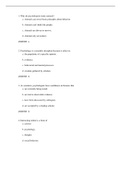Summary
Summary Developmental Psychology, 2e, ISBN: 9780077175191 Introduction In Developmental Psychology
- Course
- Institution
- Book
This document is a summary of Patrick Leman's book “Developmental Psychology”. This book is part of the exam material to be learned for the course of Introduction to Developmental Psychology, which will be taught at Leiden University during the first year of the study of Pedagogical Sciences.
[Show more]













